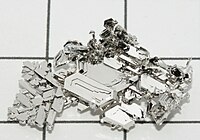
Photo from wikipedia
Methionine (Met) plays an important role in the metabolism of cisplatin anticancer drug. Yet, methionine platination in aqueous solution presents a highly complex pattern of interconnected paths and intermediates. This… Click to show full abstract
Methionine (Met) plays an important role in the metabolism of cisplatin anticancer drug. Yet, methionine platination in aqueous solution presents a highly complex pattern of interconnected paths and intermediates. This study reports on the reaction of methionine with the active aqua form of cisplatin, cis-[PtCl(NH3)2(H2O)]+, isolating the encounter complex of the reactant pair, {cis-[PtCl(NH3)2(H2O)]+·Met}, by electrospray ionization. In the unsolvated state, charged intermediates are characterized for their structure and photofragmentation behavior by IR ion spectroscopy combined with quantum-chemical calculations, obtaining an outline of the cisplatin–methionine reaction at a molecular level. To summarize the major findings: (i) the {cis-[PtCl(NH3)2(H2O)]+·Met} encounter complex, lying on the reaction coordinate of the Eigen-Wilkins preassociation mechanism for ligand substitution, is delivered in the gas phase and characterized by IR ion spectroscopy; (ii) upon vibrational excitation, ligand exchange occurs within {cis-[PtCl(NH3)2(H2O)]+·Met}, releasing water and cis-[PtCl(NH3)2(Met)]+, along the calculated energy profile; (iii) activated cis-[PtCl(NH3)2(Met)]+ ions undergo NH3 departure, forming a chelate complex, [PtCl(NH3)(Met)]+, whose structure is congruent with overwhelming S-Met ligation as the primary coordination step. The latter process involving ammonia loss marks a difference with the prevailing chloride replacement in protic solvent, pointing to the effect of a low-polarity environment.
Journal Title: Journal of the American Society for Mass Spectrometry
Year Published: 2021
Link to full text (if available)
Share on Social Media: Sign Up to like & get
recommendations!